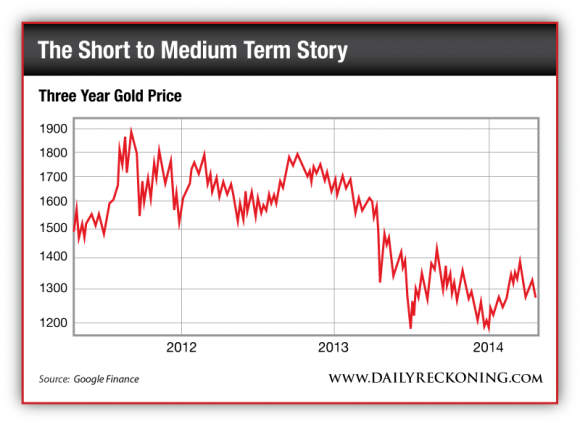The Price Floor That's Key to Gold Mining Profits
Chocolate milk isn’t my ice-cold beverage of choice. But the “brown milk” holds an important lesson for us in the gold market — as you’ll see.
Chocolate milk, however, is my 11-year-old nephew’s favorite — and lemme tell you, that boy can put away some chocolate milk!
Recently, we were hanging out drinking our brown milk, and when the taste hit my lips, I instantly teleported through the wormhole to the last time I had a chocolate milk — back in grade school. It’s amazing what a once-forgone taste or smell can do to you.
Ah, I remember the good old days of school lunch. Sitting at a table with friends, getting a break from the drone of teachers and generally living the easy life! Heck, I even had an affinity for the school menu.
Frankly, I don’t know why school lunch got such a bum rap. I loved it — every day was different. You could mix and match your pizza or steak sub with a pretzel or apple — and of course, you got the choice of regular or chocolate milk. Mmm. Mmm. Mmm.
…lunch prices in Baltimore County have surged 87% in just 16 years!
Plus, 16 years ago, my last soiree of school lunchdom, you could get all of that for just $1.60.
That’s when I turned to my nephew and asked, “Hey, how much is school lunch these days?”
“Three dollars,” he said.
Holy cow. Three bucks? I was incredulous. Sure, three bucks is a steal for a normal, outside-of-school lunch. But comparing apples to apples, that means lunch prices in Baltimore County have surged 87% in just 16 years! That’s insane.
It also brings us back to the topic of today’s article — no, not chocolate milk — I’m talking about gold!
According to the U.S. inflation calculator, the rate of inflation over the past 16 years was a “mere” 44.9% — which accounts for about half of the 87% surge in prices. I guess the other reason for increased prices comes down to local/state/federal bureaucracy or just good old shadow inflation.
That being said, a 45% drop in your purchasing power in 16 years is the hefty cost of holding U.S. dollars. That’s a losing bet if I ever saw one — and it’s written plain as day on the government’s CPI inflation calculator.
But had you paid for the same school lunch in gold, the price wouldn’t have risen at all. In fact, it would have dropped.
That’s the lesson we can learn from a small carton of chocolate milk. (And I shouldn’t need to remind you that the same buffoons that allow 45% inflation in 16 years not only affect the price of school lunch but could also have an impact your Social Security checks. Ugh.)
Needless to say, gold should still be a part of your investment philosophy. And today there’s reason to believe gold is still a worthy place to stash some cash — particularly the miners look appealing.
And — shocker alert — in case you haven’t noticed, Janet Yellen is a strong dose of the same medicine at the U.S. Federal Reserve.
The same inflationary forces at work for years are continuing to play a large role going forward. That is, the Fed is spinning cash and holding interest rates low to try to goose the economy. To an extent, it’s working, too!
It’s amazing how that works, right? Apparently, when you increase the money supply at an alarming pace and stomp interest rates to the curb, the prices for stocks, houses and everything else seem to rise.
The great inflation continues!
Not to mention, at the rate the government is spending (think Obamacare, ever-rising Social Security benefits, out-of-control congressional spending, etc.) the only way to pay back all of these greenbacks is to print ’em.
All said and done, you and I can count on the status quo at the U.S. Fed for months and years to come.
All of this inflation — and the same force that jabs the price of chocolate milk higher — is going to support the gold market. So even though right now it seems like the price of gold and gold miners are walking on ice, rest assured that there will be demand for the “once and future money”!
From my perch, we’ve found a sturdy floor for gold prices above $1,200.
Whether that support is based on inflation, money supply, supply/demand or any other fundamental factor is still up for debate. But looking at the chart, I’m confident saying it’ll take a large force to push gold below $1,200 and keep it there.
Take a look at the all-important three-year chart for gold:
I say that this chart is all-important because it tells the tale of the short- to medium-term gold market.
After hitting a high of $1,900, gold prices marched lower and continued to fall until we found support at $1,200. That is, twice since mid-2013, gold prices tried to push below $1,200, and twice, prices sharply rebounded. The second time this happened, in December 2013, we can consider this “confirmation” of that price support level.
By no coincidence, once the $1,200 price support was confirmed in December, miners got a boost.
I’ve shared this opinion before in these pages. The reason that miners caught a bid was simple: Up until that point, analysts simply couldn’t get a good read on where the price of gold was heading. Without a reliable commodity price, it was impossible for anyone to grade a miner.
But with price support at $1,200, the calculators start humming.
All things considered, I like gold miners here. I think the price of gold will stay above $1,200, and well-run miners can turn a profit.
Regards,
Matt Insley
for The Daily Reckoning
Ed. Note: Today, April 24th, was the day most people thought China would officially release its gold numbers. Well, most people thought wrong. If you were subscribed to the FREE Daily Reckoning email edition, you would’ve read all about it. Not to mention, you’d have gotten the real story why China’s hoarding gold. If you’re not subscribed to receive the DR by email each day, you’re tuning out 50% of the actionable ideas we don’t post here on our site. You should fix that. Click here now to subscribe for free, right way.




Comments: